My Way with the Leica CL (2021)
13th May 2021
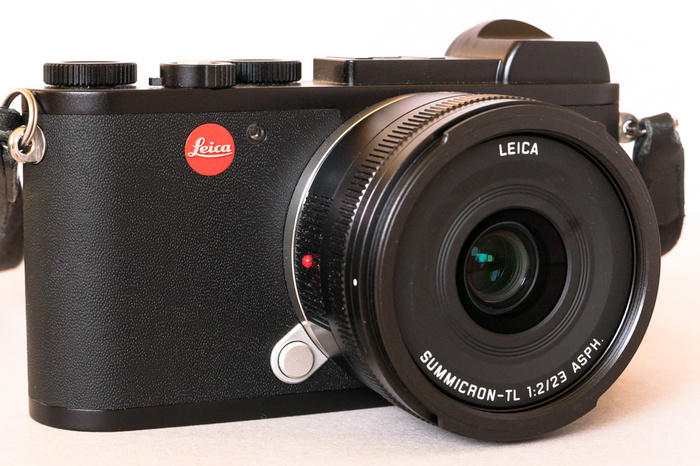
[Leica CL with Leica Summicron-TL 1:2/23 mm ASPH fitted. This is a good choice for a compact walk-about camera. It is normally used with the lens hood and hand-grip fitted] (Copyright © David Askham 2021)
The Leica CL is a very popular and proven compact system camera which has become more so since it was discontinued by Leica in May 2022, when they decided to focus on full-frame cameras. Good used examples are very hard to find, mainly because owners appreciate their design and performance, and are disinclined to sell for a pitiful trade-in allowance. So, lucky you if you already have one. I recommend that readers looking for a Leica CL should register their interest with an approved Leica dealer and wait patiently.
Initially, the operating controls divided opinion; however later firmware upgrades radically improved its handling, winning over former critics. This article is intended to help new owners achieve success and contentment using the Leica CL.
My article comprises two parts. The first is historical and can be skipped by readers already familiar with the relevance of the L-mount Alliance; although it could be useful for photographers, who are new to Leica, considering buying a used CL or, should a successor ever be launched. The second part contains a description of my way of using the Leica CL. Photographic illustrations are examples which show the diverse subjects which the CL is capable of tackling. The pandemic lockdown limited my visits to air shows and other public events. Hence the restricted pictorial coverage of these subjects. All images shown are Copyright © David Askham 2023 and are not to be republished without permission.
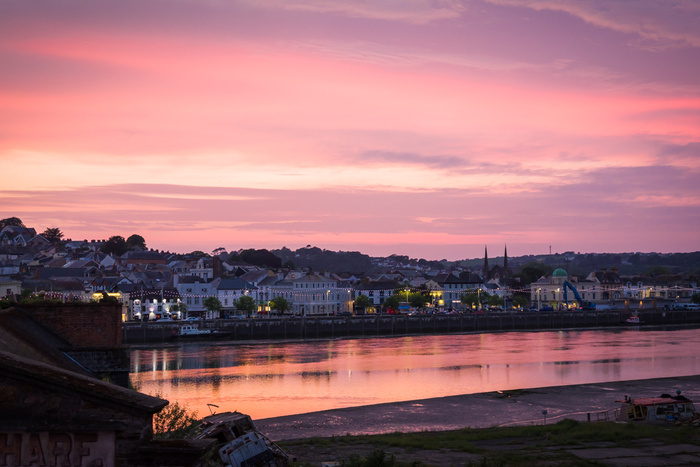
[Bideford in Devon at sunset seen across the River Torridge. (Leica CL with 18-56 zoom lens; ISO 1,000 showing good low-light performance)] (Copyright © David Askham 2021)
Part 1 - Historical background to the Leica CL
Launched by Leica in 2017, the CL has proved to be a very popular choice for photographers seeking proven quality, advanced technology and a versatile compact system camera. The CL incorporated the new Leica L-mount which was first introduced on the Leica T. Of greater significance is the fact that the L-mount has also been adopted by Panasonic and Sigma who are partners in the L-mount Alliance. Thus, lenses designed and manufactured by those industrial giants have become more affordable options for owners of the Leica CL, TL and SL. Accordingly, the range of focal lengths now available is far greater than Leica could manage for a small company. Furthermore, the L-Alliance introduces a higher level of future-proofing of the design, with a wide range of excellent lenses for many purposes. It all bodes well for the CL in the future.
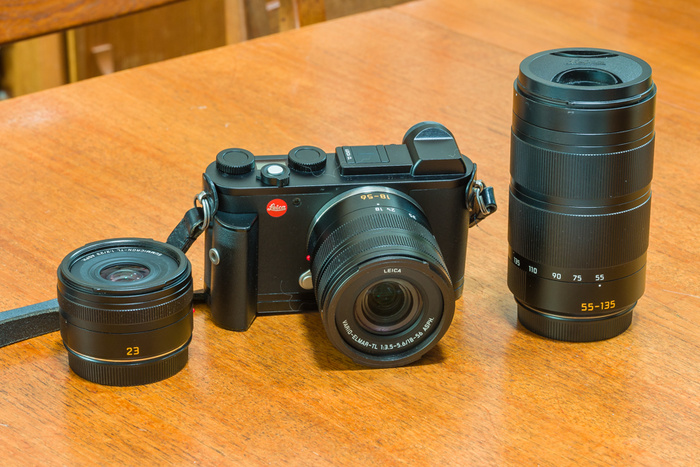
[Picture of Leica CL with my three TL Leica lenses (TL Vario-Elmar 18-56mm f/3.5-5.6 ASPH+ TL Leica Summicron 23mm f/2 + TL Vario-Elmar 55-135mm f3.5-4.5 ASPH)These three lenses make for an efficient and capable camera kit for serious travelling] (Copyright © David Askham 2021)
The Leica CL system may also be considered a partial natural successor to the discontinued fixed-lens Leica X family. The X-series retains many devotees, worldwide. Indeed, in my view, nothing quite matches the compactness of the original Leica X1, which I still enjoy using and have written about on my website. In purely volume terms, the Leica CL fitted with the Leica 18mm pancake lens does come close. However, it yields the equivalence of a full-frame 28mm lens, rather than 35mm for the Leica X1. To achieve comparable angular coverage, the Leica CL would need the L-mount 23mm Summicron lens fitted; while this would increase its usefulness, it would also add to its bulk, compared with the diminutive X1.
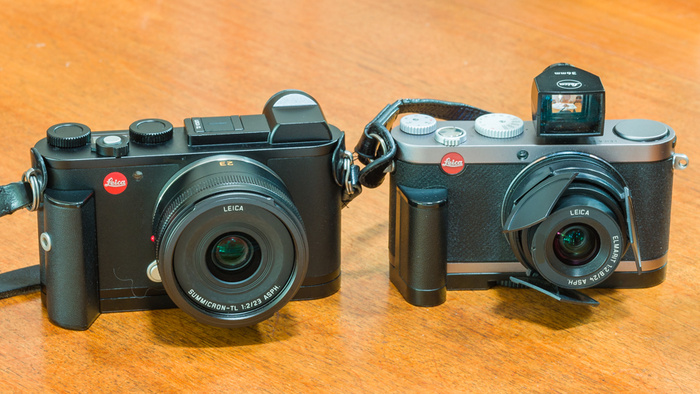
[Leica X1 beside Leica CL fitted with equivalent focal length lens (Copyright © David Askham 2021)]
Another popular member of the X-family is the X Vario with fixed zoom lens. Good used examples of this camera are hard to find, which reflects the reason for their continued popularity. It is such a lovely camera to handle and operate, despite its ugly add-on EVF. [Pic Back-to-back]It is one of the last Leica cameras with recognizable analogue features, such as the shutter speed, lens aperture dials, and focusing scales. For close-up work it scores valuable points over its standard zoom equipped CL rival. But this article will now concentrate on how I use the Leica CL.

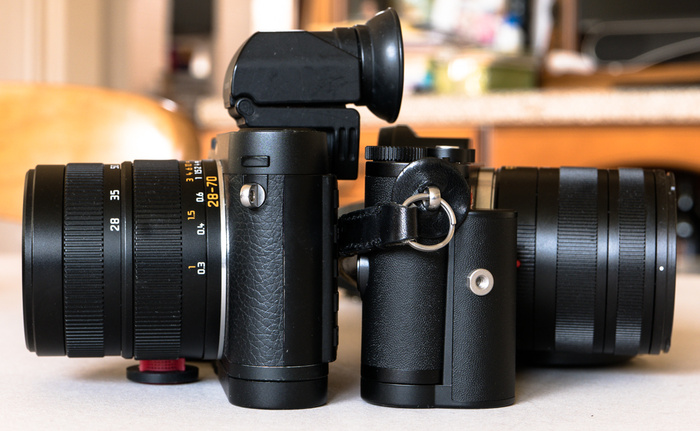
[Two views of Leica X Vario and Leica CL with equivalent standard zoom lenses. The first is fixed; the second replaceable with a different lens. Note that lens hoods are normally fitted when in use and the X Vario uses a detachable electronic viewfinder which can swing up to 90°] (Copyright © David Askham 2021)
What is the Leica CL?
The Leica CL is a compact 24 megapixels, APS-C mirrorless system camera announced by Leica Camera AG in November, 2017. There are rumours of a successor arriving sometime later in 2021. However, the current original model remains very popular.
The CL accepts any L-mount lens or most interchangeable lenses by Leica via an appropriate bayonet adapter. A bright clear EVF (electronic viewfinder) is one of its strengths. It is a brilliant and accurate way to frame a new photograph. Unusually, conventional dials take on variable roles, which can be set-up by the user to meet different styles of working. The system offers considerable flexibility, once mastered by the user. Initially that was not exactly welcomed by traditional photographers. But for the younger generation, which lives with its smart-phones, touch-screen and soft-keys are commonplace. So, there is a degree of reluctance on the part of ‘oldies’, more used to setting analogue controls. Happily, perseverance pays dividends and most users find their personal way of working.
One other interesting feature; Leica has only launched seven native L-mount lenses to accompany the Leica CL. They cover focal lengths from 11mm to 135mm of which three lenses are zoom and four are primes. All are excellent and incorporate auto-focus, but not image stabilisation. The latter is a feature which many hope to see incorporated in any future CL model. To offset this glaring deficiency, when compared with the legendary range of lenses with M-mount, is that participating companies which are part of the L-alliance have added very many lenses which help to fill the gaps in speed and focal lengths. Some of these non-Leica lenses do incorporate image stabilisation.
The rest of my article comprises personal techniques for getting results which please me and suit my style of working.
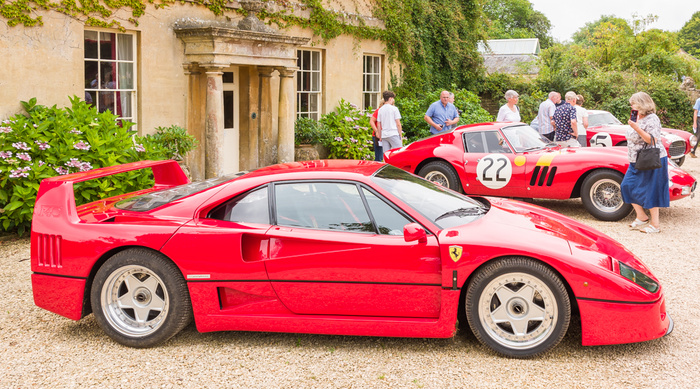
[Two car pictures demonstrate the usefulness of the versatile standard zoom lens on the CL camera. The Ferrari F40 was one of a collection of rare cars open to the public to raise funds for charity. In comparison, the old Jaguar was in a fascinating motoring museum in the Cotswolds (Copyright © David Askham 2021) ]
[Ferrari F40 (Leica CL + Vario-Elmar TL 1:3.5-5.6/18-56 mm ASPH) (Copyright © David Askham 2021)]
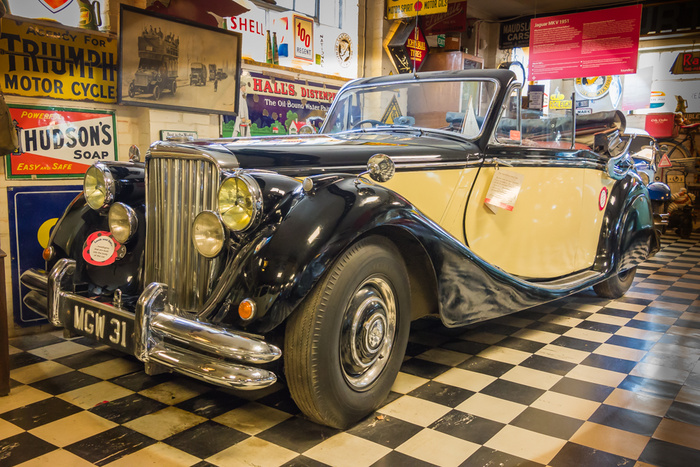
[Jaguar Mk V (Leica CL + Vario-Elmar TL 1:3.5-5.6/18-56 mm ASPH)
A rare specimen of a Jaguar Mk V Drop-head version built in 1951. Mixed lighting indoors; handheld at 1/60 sec at maximum aperture using ISO 2500. This shot shows that a slow standard zoom lens performs very well in low-light situations (Copyright © David Askham 2021)]
A rare specimen of a Jaguar Mk V Drop-head version built in 1951. Mixed lighting indoors; handheld at 1/60 sec at maximum aperture using ISO 2500. This shot shows that a slow standard zoom lens performs very well in low-light situations (Copyright © David Askham 2021)]
Part 2 - My way with the Leica CL
1. My first tip for a novice is to master one operating mode fully before becoming adventurous and confused by changing the functions of ‘soft’ controls. Transitioning from analogue or hybrid camera controls to multi-role unnamed ‘soft’ dials has many traps for the unwary. You cannot reliably assume that an adjustment dial consistently performs one job, like setting aperture or exposure compensation. The user is obliged to concentrate on menus and function buttons which can slow down a newcomer to the system. Yet it is remarkably versatile provided you learn the system. So concentrate on using one mode successfully and repeatedly before trying others. The default settings are a good place to start and the camera will behave like any you have used before. The Main Menu screen is new, introduced by firmware update, and should be used to review and change many critical settings.
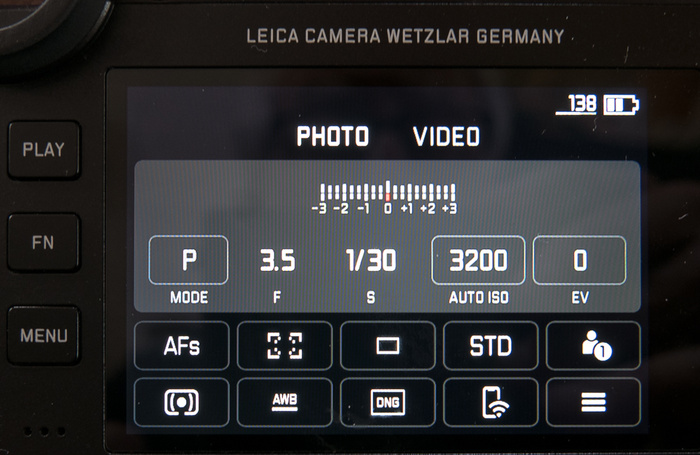
[The introduction of this new main Menu touch-screen (Firmware Update 4.0) has transformed the interface between photographer and camera. It is my starting point before any serious photography and allows me to check and adjust most of the important settings.(Copyright © David Askham 2021)]
2, Second, once you have settled on your preferred mode and camera settings, save them as a named User Profile. I do not know why, but many photographers refuse to master this simple tool. Just try it and see for yourself. (Details of how to do this are included in the User Manual which I recommend you request from Leica. If not available, go to Main Menu page 3>User Profile>Manage Profiles>Save as Profile. I have User Profiles as one of my Favourites so that I can find it quickly when wishing to modify a profile).
Your personal default and named profile should be your baseline to which you can quickly and safely return, after making random changes to settings in the field. While you might start with your default User Profile, it is normal or tempting to make further adjustments to settings, during travels. They thus cease to be your set User Profiles. Hence the advice to restore your default profile, from time to time, and certainly when changing your locations or genre.
3. Third, at the end of a photographic session, restore your Default Profile. Do it instinctively and you avoid a lot of exposure or white balance errors. For example, inside a museum you need higher ISO settings and a different White Balance, perhaps for tungsten lighting. When you return to the street, most of those temporary indoor settings are inappropriate. So by resetting your User Profile you ensure that your fail-safe settings are in place. That simple act saves a lot of frustration and post-production work to rectify your mistakes.
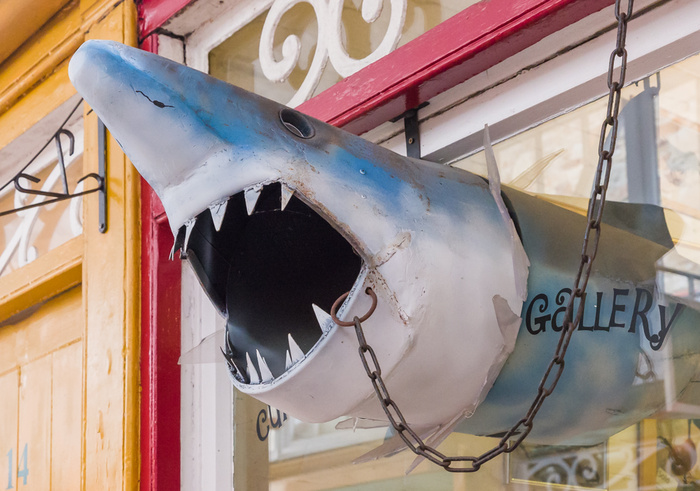
[Picture of Shark (Leica CL + Vario-Elmar TL 1:3.5-5.6/18-56 mm ASPH)
Accidental use of ISO 6400 served to show that the setting can be used without undue detriment to a CL image. Lesson learned: watch the ISO if left on Auto ISO, when entering lower light interiors such as this indoor market (Copyright © David Askham 2021)]
Accidental use of ISO 6400 served to show that the setting can be used without undue detriment to a CL image. Lesson learned: watch the ISO if left on Auto ISO, when entering lower light interiors such as this indoor market (Copyright © David Askham 2021)]
4. Fourth, make the default setting of your Function button ‘EVF - LCD’. Why do I say that?
Well in my experience, the camera and lens operations consume a lot of power if used excessively and indiscriminately. Image stabilization on non-Leica lenses is particularly power-hungry. So is running an active LCD. Once you are familiar with camera operation and settings, you can switch off the LCD and concentrate on framing your shots and adjusting settings from data visible in your EVF (Electronic Viewfinder). If you need to check your results, just press the Function button to view and again to hide the LCD. You will be pleasantly surprised how much longer your battery will last before it needs replacing and recharging.
5. Fifth, the standard L-mount zoom lens (18-56mm) equates to roughly 28mm to 85mm. It is a truly excellent lens designed to match the performance of renowned M-mount rangefinder lenses. Despite the fairly slow initial lens aperture of f/3.5, use of higher ISO settings more than compensates for the loss of speed when compared with prime lenses. All Leica lenses can be used successfully at their widest lens apertures. You do not have to stop down to reach acceptable performance. The big advantage of using a zoom lens is the extra versatility in changing the focal lengths for framing or effect purposes.
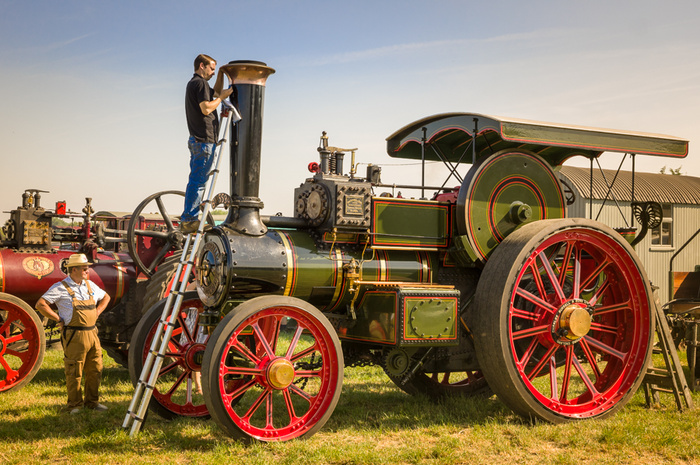
[A 100 years-old working Burrell steam traction engine called 'Independence'. The standard zoom lens is ideal for events such as this Steam Rally in UK. (Leica CL + Vario-Elmar TL 1:3.5-5.6/ 18-56 ASPH at 35 mm) (Copyright © David Askham 2021) ]
There are three zoom lenses in the range, but buying the camera together with the standard zoom lens makes a lot of sense. I strongly recommend starting with this lens, which is available as part of a Leica CL camera kit.
I have not felt the need for the wide-angle zoom, but the results are equally good. However, I later added the tele-zoom (55-135mm), which equates to 85mm to 200mm, and is a spectacular lens; I find it excellent for animal, portrait, aviation and landscape photography. I also use it effectively to isolate plants and garden features which are out-of-reach with normal lenses. It is just a surprisingly good lens for isolating details in an urban, garden of rural landscape. I never regret buying this lens.
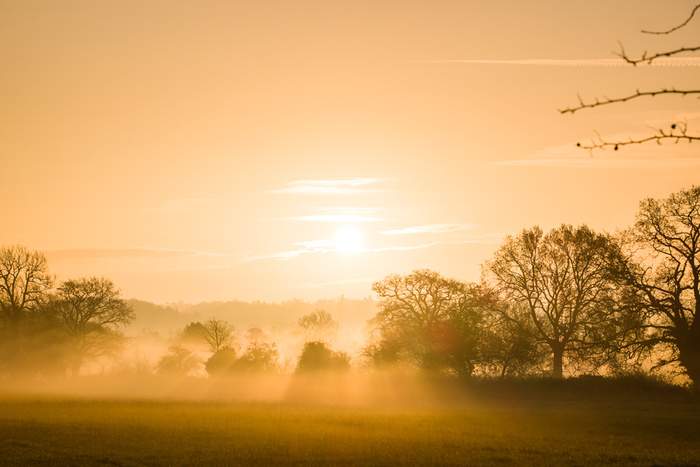
Early morning mist over Wiltshire. The Leica tele-zoom lens is perfect for picking out details in a landscape. (Leica CL + Apo-Vario-Elmar-TL 1:3.5-4.5/55-135 ASPH at 55 mm) (Copyright © David Askham 2021) ]
6. Sixth, is the opportunity to use manual-focusing Leica M and R-mount lenses via an adapter which transfers lens recognition in many cases. R-mount lenses were once remarkably cheap after Leica stopped making R-cameras. Not so, nowadays, as photographers realised their value when attached to a Leica CL body. Consequently, the younger Leica CL system camera has breathed new life into many obsolescent lenses made up to nearly a century ago. That fact alone opens up so many possibilities. (See my earlier article featuring the venerable 135mm Elmar lens from the 1960s published here)
7. Seventh, the Leica CL fitted with the faster 23mm f/2 Summicron effectively replaces my X1 for those occasions when travelling light is important. It is a very potent light weight compact solution. The results are so good that modest cropping effectively replaces the need for longer focal length lenses deliberately left at home. It also performs a valuable role in low-light or grotty weather conditions. The extra stop really counts.
8. Eighth, compensate for the absence of inbuilt image stabilization by using time-honoured methods. Yes, I am talking about choice of shutter speeds when the use of a tripod is not an option. This technique will already be well-known to older photographers; but those weaned on automation can learn how to combat unwanted subject movement or camera shake by using higher shutter speeds, appropriate to the conditions and subjects.
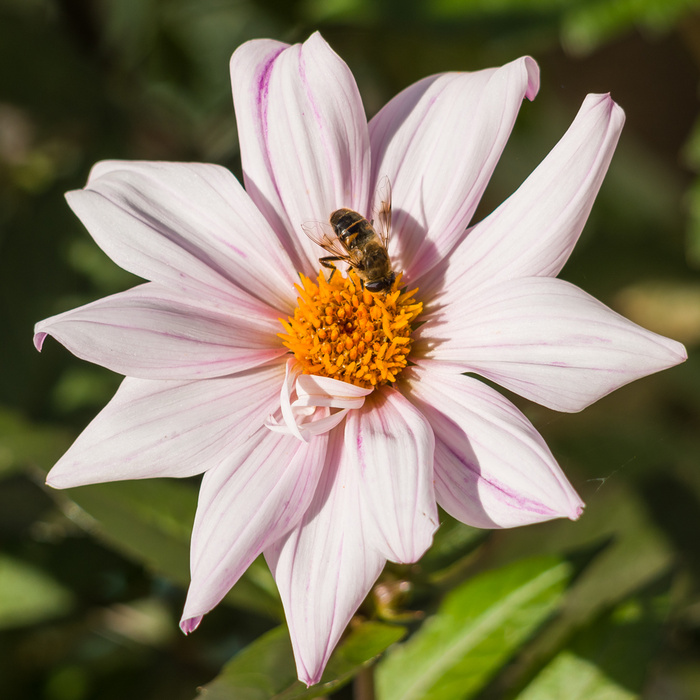
Dahlia and pollinator (Leica CL + Sigma 100-400mm DN OS Contemporary 020 lens at 214 mm) ]
The choice of using a Sigma 100-400mm zoom lens for close-ups is a new departure for me. The use of an effective 321mm focal length removes me from hovering very close to the sensitive subject and disturbing it. The lens offers amazing close-up capabilities. (Copyright © David Askham 2021)
The choice of using a Sigma 100-400mm zoom lens for close-ups is a new departure for me. The use of an effective 321mm focal length removes me from hovering very close to the sensitive subject and disturbing it. The lens offers amazing close-up capabilities. (Copyright © David Askham 2021)
I was recently reading an interesting book on street photography by expert photographer Matt Stuart. Most of the book discusses the psychology and practicalities of the genre; very little is written about the equipment he uses. Hidden in that sparse reference to technical matters, was his practice of setting his shutter speed to 1/1000 second. He mostly uses 35 mm or 50 mm lenses. He argues that his choice eliminates camera shake and most subject movement. Whether you agree with his choices or not, it helps him to achieve considerable success in practice. I would argue that it is worth considering using a higher shutter speed whenever there is a risk of poor capture. If necessary, do not shirk from using Auto ISO at higher values. Modern sensors make this possible. Practice alternative techniques in pursuit of success. (See my thoughts on street photography here https://www.davidaskham.com/thoughts-on-street-photography )
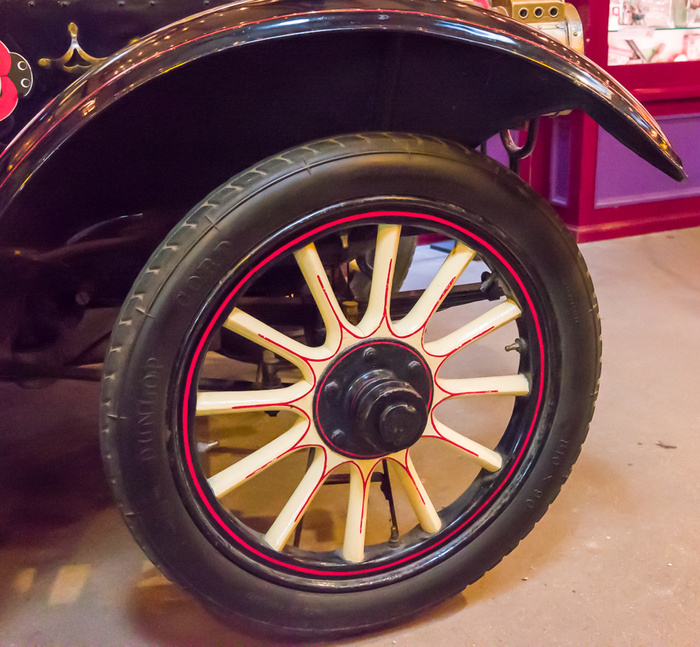
[The picture of a wooden spoked automobile wheel necessitated the use of ISO 12,500, a setting not available in my early days as a photographer. It is not one I would normally choose; but the evidence shows that it is a workable solution in low light with a standard zoom lens. (Copyright © David Askham 2021)]
9. My ninth and final recommendation concerns Hybrid focusing. I am amazed that more users do not take advantage of this valuable technique.
Hybrid focusing takes auto-focusing one stage further. Using your favoured auto-focusing method, focus, hold, and simultaneously tweak the focus manually to ensure that the focus point is precisely where you want it to be. Focus peaking can help. This technique is invaluable in situations where unwanted conflicting objects can steal your well-intentioned autofocus points. An example is a beautiful rose bloom with non-flowering branches intruding into view. Autofocus tends to pick the nearest object within its field. In many cases that is not a problem. When it is, resort to Hybrid focusing and be amazed at the increase in your focusing success rate.
Conclusions
In the world of Leica, the CL compact system camera is a justifiably pleasing and satisfactory choice for a wide range of photographic applications. It is not perfect, but Leica has continued to introduce new features which might well have merited the launch of a new model in the past. A good example is the comprehensive new Menu front page which was not available at first launch. Now it handles delightfully, is versatile and small enough to be a constant companion, whatever your photographic interests. It is so good that I rarely use the original controls when out shooting.
Taking account of the L-Alliance, we can only hope that by widening the scope of third-party cooperation, the CL system will continue to be developed further by participating companies. If so, I see many reasons for this efficient and capable system to be productive for years to come, subject to continuing support from component suppliers.
Would I rush to upgrade the CL, should a successor become available? It would depend on the advantages on offer. Image stabilisation would be a major temptation, despite my not having suffered too much as a result of its absence in the current model. One thing is for sure: I would not trade in my current model. It would be far more use to me as a back-up, or part of a two-bodies travel kit. But, at the time of writing, this is all hypothetical. Meanwhile, I shall continue to enjoy my CL with confidence that is an excellent system. As such, it is highly likely to be equally successful with the second generation of owners, who are new to Leica, and would like to take advantage of easing secondhand prices, should a CL2 be launched one day. I hope this article will be of value to them and all who are new to CL ownership.
Happy Shooting!
(Copyright © David Askham 2021)
Comments
 By Don Morley: A terrific web site David thank you for sharing it and your working methods with us. Like yourself I use a Leica CL but in addition to several other Leica's including a T, Q, and my digital SL and I certainly agree the latest firmware has made the CL far nicer and more user friendly to use, though it will never be my favourite camera. Best wishes, Don
By Don Morley: A terrific web site David thank you for sharing it and your working methods with us. Like yourself I use a Leica CL but in addition to several other Leica's including a T, Q, and my digital SL and I certainly agree the latest firmware has made the CL far nicer and more user friendly to use, though it will never be my favourite camera. Best wishes, Don By David Askham: Thank you, Don. Your comments are much appreciated. I am aware that the CL has competition in your stable. It pleases me that you enjoy it, just a little more, since its major upgrade.
Keep safe.
Best Wishes David
By David Askham: Thank you, Don. Your comments are much appreciated. I am aware that the CL has competition in your stable. It pleases me that you enjoy it, just a little more, since its major upgrade.
Keep safe.
Best Wishes David By Dennis Steel: I like your web-site write up on the CL Leica camera and as a fellow enthusiast I would like to add the way I see and use the Leica CL camera
1. The Leica CL (compact camera) is very light to carry with my chosen lens TL Vario-Elmar 18-56 mm lens fitted I can carry this set up all day without feeling fatigued.
2. The menu system since the upgrade is very accessible with one touch of the menu button to gain access to the icon menu another touch of the menu button, and you are into your favourite menu and then a scroll down, and you can access the main menu. Wonderful!
3. To improve the camera’s day-to-day operation you have five function buttons you can allocate. I have set up the right hand soft button to bring up the exposure compensation. On the left-hand side of the camera I have set the FN button to bring up the ISO settings these are my most go to buttons.
4. The special features I like within the menu system and are easy to set and give the Camera great versatility and capacity to take photographs are as follows; Scene Mode, HDR, Panoramic, B&W nat (natural) and B&W hc (high contrast).
5. Leica FOTO app works well on the CL camera I like setting the camera on a tripod in the garden on a subject (normally birds) and controlling the camera from my seat in the garden some distance away.
6. The video function is easy to set up from the menu system when you just have to take some action sequence.
7. The range of shutter speeds available from the camera is amazing Mechanical shutter from 30sec to 1/8000sec. The electronic shutter from 1sec to 1/25000sec.
8. My favourite lens in the range of TL lens is the 60 mm f2.8 Macro I have had a lot of pleasure from photographing plants and insects from my garden.
By Dennis Steel: I like your web-site write up on the CL Leica camera and as a fellow enthusiast I would like to add the way I see and use the Leica CL camera
1. The Leica CL (compact camera) is very light to carry with my chosen lens TL Vario-Elmar 18-56 mm lens fitted I can carry this set up all day without feeling fatigued.
2. The menu system since the upgrade is very accessible with one touch of the menu button to gain access to the icon menu another touch of the menu button, and you are into your favourite menu and then a scroll down, and you can access the main menu. Wonderful!
3. To improve the camera’s day-to-day operation you have five function buttons you can allocate. I have set up the right hand soft button to bring up the exposure compensation. On the left-hand side of the camera I have set the FN button to bring up the ISO settings these are my most go to buttons.
4. The special features I like within the menu system and are easy to set and give the Camera great versatility and capacity to take photographs are as follows; Scene Mode, HDR, Panoramic, B&W nat (natural) and B&W hc (high contrast).
5. Leica FOTO app works well on the CL camera I like setting the camera on a tripod in the garden on a subject (normally birds) and controlling the camera from my seat in the garden some distance away.
6. The video function is easy to set up from the menu system when you just have to take some action sequence.
7. The range of shutter speeds available from the camera is amazing Mechanical shutter from 30sec to 1/8000sec. The electronic shutter from 1sec to 1/25000sec.
8. My favourite lens in the range of TL lens is the 60 mm f2.8 Macro I have had a lot of pleasure from photographing plants and insects from my garden. By David Askham: Dennis, I appreciate your contribution which demonstrates, very well, how versatile is the Leica CL. Thank you. There are controls and features for all interests. I am glad you mentioned FOTOS, an application which has allowed me to capture natural self-portraits during lockdown. It is also a useful aid to shooting natural history subjects. Enjoy your CL. I am sorry the Comments section does not recognize the listing of your points. At least they are there for all to read and enjoy. Thank you.
By David Askham: Dennis, I appreciate your contribution which demonstrates, very well, how versatile is the Leica CL. Thank you. There are controls and features for all interests. I am glad you mentioned FOTOS, an application which has allowed me to capture natural self-portraits during lockdown. It is also a useful aid to shooting natural history subjects. Enjoy your CL. I am sorry the Comments section does not recognize the listing of your points. At least they are there for all to read and enjoy. Thank you. By Jim Donato: Thanks David. I have incorporated a few of your suggestions and was already using several others. For me, the CL replaces the small D-Lux 7 I was using AND a large bulky DSLR. For anything other than my medium format fine art landscapes, the CL is more than capable.
By Jim Donato: Thanks David. I have incorporated a few of your suggestions and was already using several others. For me, the CL replaces the small D-Lux 7 I was using AND a large bulky DSLR. For anything other than my medium format fine art landscapes, the CL is more than capable. By David Askham: Jim, thank you for your comment on ‘My way with the Leica CL’. It is pleasing to hear that the CL has found a useful niche between other cameras in your tool-set. It is also rewarding to know that we can continue to learn from each other. Happy shooting!
By David Askham: Jim, thank you for your comment on ‘My way with the Leica CL’. It is pleasing to hear that the CL has found a useful niche between other cameras in your tool-set. It is also rewarding to know that we can continue to learn from each other. Happy shooting! By Guy MARQUES: A big thank you David for your reflection on the Leica CL that I have for 6 months.
It came to replace an X Vario and its excellent optics (thank you M. Peter Karbe) and despite what its detractors think...
I couldn't keep both, but I admit that the CL really overwhelms me with its thoughtful controls and superb viewfinder.
I just added to the 18 mm and 18-56 mm a magnificent Sigma macro 105 mm DG DN. What an optic !
On the other hand, I cannot ged rid of my antique Digilux 2 nor of my little D-Lux 5...
Thank you once again for your valuable contribution on the use of the Leica CL and for the work that this entailed.
Guy(tou) MARQUES
By Guy MARQUES: A big thank you David for your reflection on the Leica CL that I have for 6 months.
It came to replace an X Vario and its excellent optics (thank you M. Peter Karbe) and despite what its detractors think...
I couldn't keep both, but I admit that the CL really overwhelms me with its thoughtful controls and superb viewfinder.
I just added to the 18 mm and 18-56 mm a magnificent Sigma macro 105 mm DG DN. What an optic !
On the other hand, I cannot ged rid of my antique Digilux 2 nor of my little D-Lux 5...
Thank you once again for your valuable contribution on the use of the Leica CL and for the work that this entailed.
Guy(tou) MARQUES By David Askham: Guy, I really appreciate your taking time to comment on my CL article. In fact, you represent the typical photographer for whom I was writing. I am so pleased you found it helpful. We are constantly learning and the world is richer for those who meet in cyber-space to exchange notes on their experiences with various cameras and lenses.
I still have my Digilux 2 and can’t bear to part with it. It serves as a reminder of my early days learning about digital photography. And the dear little D-Lux cameras are still useful when photography is not the prime purpose for leaving home.
Wishing you many happy years with your cameras.
By David Askham: Guy, I really appreciate your taking time to comment on my CL article. In fact, you represent the typical photographer for whom I was writing. I am so pleased you found it helpful. We are constantly learning and the world is richer for those who meet in cyber-space to exchange notes on their experiences with various cameras and lenses.
I still have my Digilux 2 and can’t bear to part with it. It serves as a reminder of my early days learning about digital photography. And the dear little D-Lux cameras are still useful when photography is not the prime purpose for leaving home.
Wishing you many happy years with your cameras. By jaap: A very good summary, David, very useful. Thanks for taking the time.
By jaap: A very good summary, David, very useful. Thanks for taking the time. By David Askham: Thank you Jaap. Very much appreciated.
By David Askham: Thank you Jaap. Very much appreciated. By SJZ: Thank you, lovely review, really useful.
By SJZ: Thank you, lovely review, really useful. By Duncan Kirkwood: Excellent and useful ... TYVM.
By Duncan Kirkwood: Excellent and useful ... TYVM. By David Askham: Thank you, Duncan. Much appreciated.
By David Askham: Thank you, Duncan. Much appreciated. By Gerry Phillipson: Very many thanks for this post. It's very informative and eases the learning curve. It's always useful to learn how another person uses the same camera.
By Gerry Phillipson: Very many thanks for this post. It's very informative and eases the learning curve. It's always useful to learn how another person uses the same camera. By David Askham: Much appreciated, Gerry. Thank you.
By David Askham: Much appreciated, Gerry. Thank you. By David: Hi Have just read your two CL articles. Very clear. I am thinking of "downsizing" from SL2S (with 24-70) to a CL. The Sl2S is too big. I am puzzled that some CLs are called 19301 and others (incl Leica website) are called 19345. Is there a difference?
By David: Hi Have just read your two CL articles. Very clear. I am thinking of "downsizing" from SL2S (with 24-70) to a CL. The Sl2S is too big. I am puzzled that some CLs are called 19301 and others (incl Leica website) are called 19345. Is there a difference? By David Askham: Hello David,
Thank you for your comments. Regarding your query, My black CL is Part Number 19301. I think the silver might be slightly different, as might be CL cameras sold as part of a kit containing one lens. You will certainly notice a difference between the two cameras after down-sizing. It is a much more comfortable weight to carry, either alone, or as part of a kit. I hope you make the right choice for you.
By David Askham: Hello David,
Thank you for your comments. Regarding your query, My black CL is Part Number 19301. I think the silver might be slightly different, as might be CL cameras sold as part of a kit containing one lens. You will certainly notice a difference between the two cameras after down-sizing. It is a much more comfortable weight to carry, either alone, or as part of a kit. I hope you make the right choice for you. By David Cantor: First up, Christmas Greetings and I'd like to wish you a happy and successful New Year. Two days ago I had my first real outing with the CL and the 35mm f/1.4. First realisation is that wide open, the DOF is very shallow and I need to be much more careful when taking portraits. Is it possible to enlighten this newbie about hybrid focusing over and above that covered in para 9, please think photography for dummies. I agree with you about Matt Stuart's book, his general philosophy and also his advice about sequencing and pairing images for a photo book - very valuable. Thanks and best wishes, David
By David Cantor: First up, Christmas Greetings and I'd like to wish you a happy and successful New Year. Two days ago I had my first real outing with the CL and the 35mm f/1.4. First realisation is that wide open, the DOF is very shallow and I need to be much more careful when taking portraits. Is it possible to enlighten this newbie about hybrid focusing over and above that covered in para 9, please think photography for dummies. I agree with you about Matt Stuart's book, his general philosophy and also his advice about sequencing and pairing images for a photo book - very valuable. Thanks and best wishes, David By David Askham: David, thank you for your greetings and comments on the Leica CL; which I warmly reciprocate. While I am not an expert on street photography, I agree that the 35mm Summilux is challenging in use for street shooting, particularly at full aperture. I would not use it in daylight wider than, say, f/4; usually more likely f/8. But it depends what you are seeking; learn from your experiments. As you have found, the margin for error is much greater at f/1.4, unless the subject is static and you want isolation from the background. Having said that, choice of aperture priority mode, enables you to limit the risks of unsharpness. On your second point, I have emailed you on the subject of hybrid focusing and will be reviewing my article to make sure it is clearer to someone new to the concept. Once you master the technique, it will become an automatic part of your handling technique. Thank you for your interest.
By David Askham: David, thank you for your greetings and comments on the Leica CL; which I warmly reciprocate. While I am not an expert on street photography, I agree that the 35mm Summilux is challenging in use for street shooting, particularly at full aperture. I would not use it in daylight wider than, say, f/4; usually more likely f/8. But it depends what you are seeking; learn from your experiments. As you have found, the margin for error is much greater at f/1.4, unless the subject is static and you want isolation from the background. Having said that, choice of aperture priority mode, enables you to limit the risks of unsharpness. On your second point, I have emailed you on the subject of hybrid focusing and will be reviewing my article to make sure it is clearer to someone new to the concept. Once you master the technique, it will become an automatic part of your handling technique. Thank you for your interest.